
Sorry for the quiet time here; some travel and work obligations have kept me out of the kitchen more than I’d like. Before I get into this dish, I found something interesting I thought I might share. On a recent weekend trip, I finally had the time to read “Life, On The Line”–Chef Achatz and Nick Kokonas’ co-written story about their lives and the creation of Alinea. In it, I found this quote:
“It is impossible to try to innovate. You can’t decide to turn creativity on or off. All you can do is present yourself with interesting problems and try to find solutions. Then you refine those solutions again and again”.
–Grant Achatz
I thought this was particularly timely…I think I was smiling outright on the plane as I read it. Incidentally, there is a decent handful of pretty nice quotes throughout the book (which is a great read). Here are some other ones I bookmarked:
“On a bad night we would take comfort in knowing that we always had tomorrow to get it right.”
–Grant Achatz
“Of course, when you don’t care about the outcome of something, you perform your best.”
–Nick Kokonas
“…the most important aspect of what I did [comes] from within, not the ability to taste or evaluate the completed dishes.”
–Grant Achatz
As someone who’s invested no small amount of energy second-guessing myself and conjecturing about every little aspect of all of this, I found some comfort, reassurance, and encouragement here.
But let’s talk about some cool-ass food now.

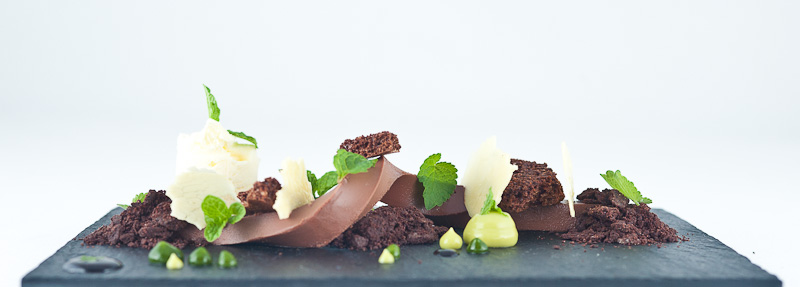
I’ve got a lineup of fall dishes picked out for myself, and I meant to start up on them a month and a half ago, but I’m having trouble letting go of summer. The dishes I’ve picked out also don’t have huge produce dependencies, so I can be a lot more flexible with them. This one was Sarah’s choice; she’s wanted a dessert dish for weeks and kept pointing at this one as one she thought she’d like.
Let’s take a little visual tour of what all is included here:
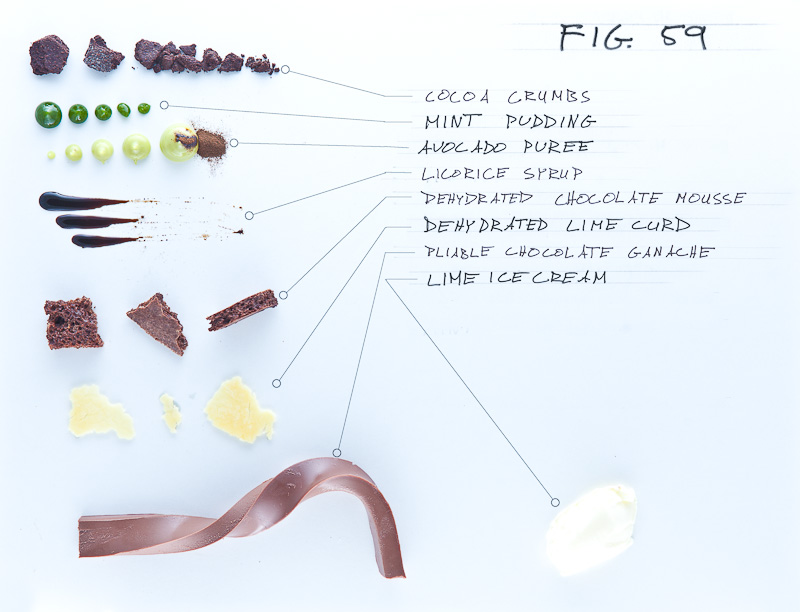
This recipe uses what’s known in the restaurant biz as “a fuck ton of chocolate”. Seriously, between the cocoa powder and the solid chocolate it uses around 3lbs, plus another pound or so if you screw something up like I did.
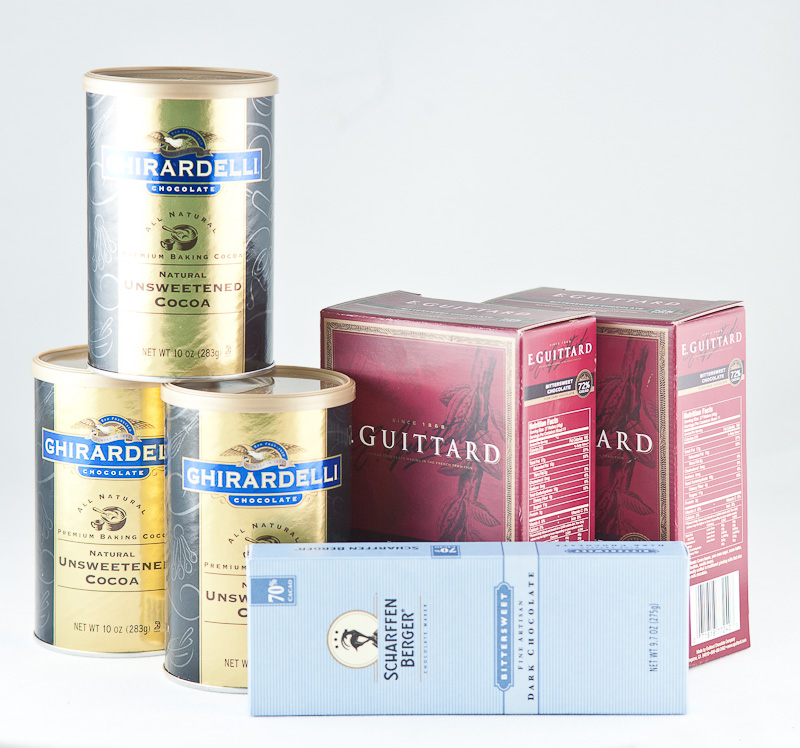
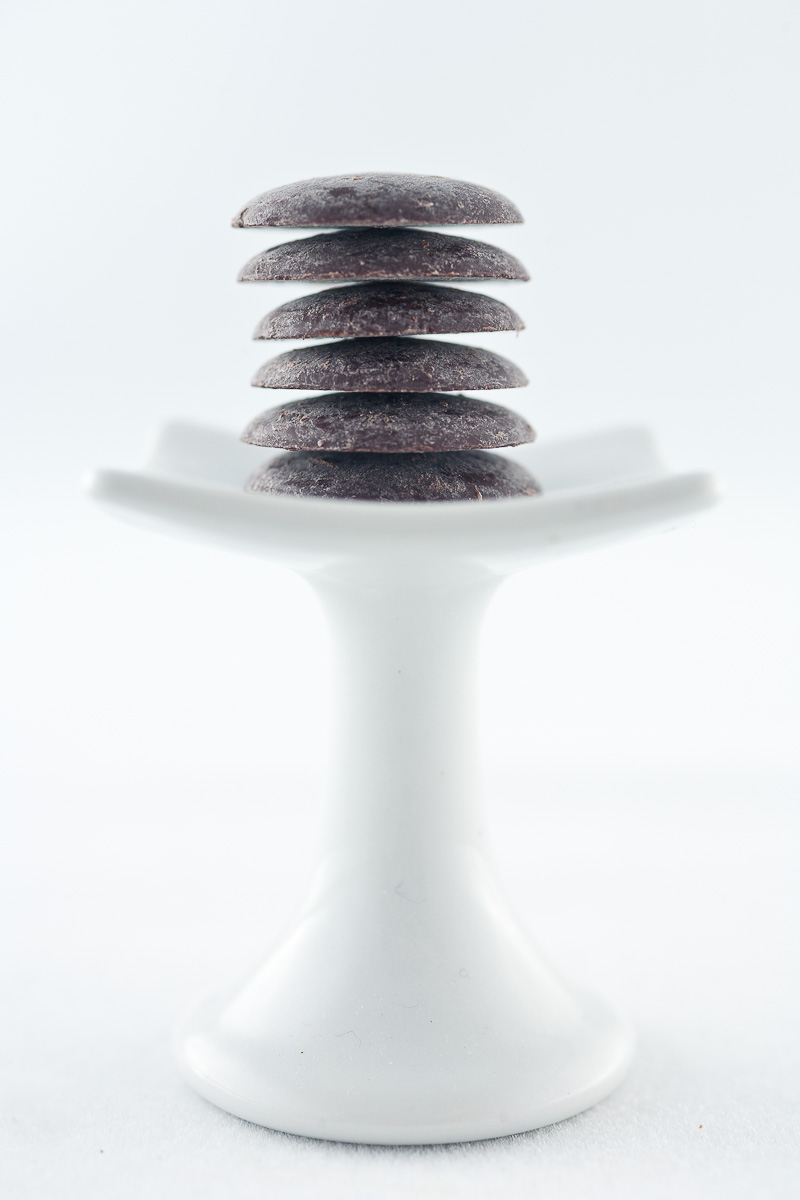
I started working on this one mid-week, and tried to choose parts of the recipe that seemed like they’d stay stable the longest. The first thing I made was a bottle full of Licorice Syrup, which involves cooking some dry licorice extract with sugar, glucose, and a bit of cocoa powder. The recipe yields a MASSIVE amount of syrup, so I quartered it and still ended up with two squeeze bottles full.
At the same time, I also made Mint Pudding. Usually the ‘puddings’ the cookbook are made by blanching a healthy amount of herbs and using agar as a thickener. This one was a little different; it had a dependency on xanthan gum and glucose in addition to agar, which I found interesting. It also made use of something called Calcium Ascorbate:
Calcium Ascorbate is a neutral (non-acidic) form of vitamin C. Commercially it’s sold under the brand name “Ester-C”, or as “buffered vitamin C”; because it’s not acidic, it tends to upset one’s stomach less, and doesn’t burn one’s tongue the way regular vitamin C can. It’s also sometimes used as a food additive, to keep foods like fresh cut apples from browning. It tastes a bit like baking powder.
I assumed this was used to preserve the brilliant emerald green color of the pudding, without giving it the notable tang that citric acid or some other acid preservative would have offered.
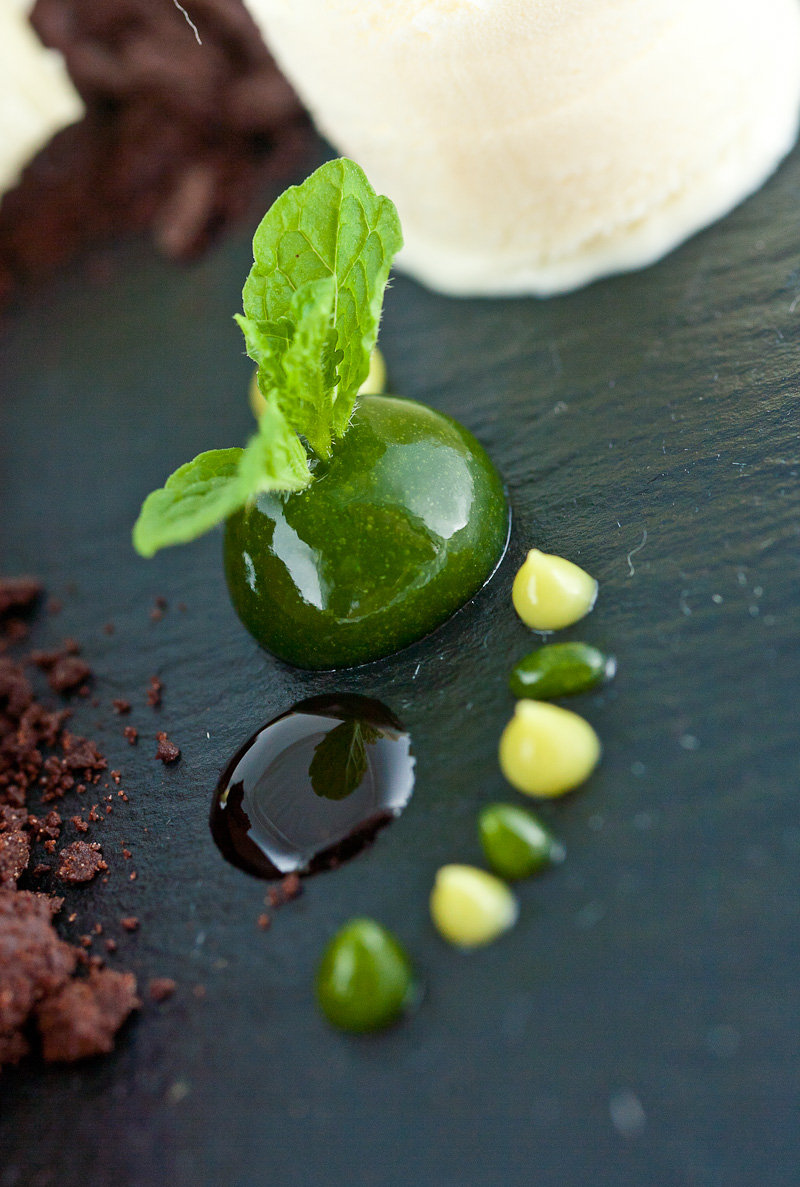
Next I made some avocado puree. This was pretty easy and fun; put some avocados in a blender (you get about 100g avocado flesh per fruit…the pit is very dense) along with some glucose, sugar, malic acid and xanthan gum, and pour in enough boiling water to help things along when the blender is turned on. You end up with a perfectly smooth pudding that I again bottled in a squeeze bottle. I hadn’t used malic acid before, so I hit up wikipedia:
Malic acid is a fruit-derived acid similar to Citric acid; it’s usually derived from apples and is more tart. In food usage, it’s typically the main ingredient in ‘extreme candy’ like Warheads or other very-tart hard candies.
So, it seems the malic acid is meant to add some tartness to the puree and also keep it from browning; I’m not sure exactly why one wouldn’t use citric acid to accomplish this though. This is the only spot in the cookbook that uses this ingredient, and citric acid is used frequently elsewhere, so I’m curious what’s different here. The puree does have a definite tartness; it tastes almost like some sort of lime puree, in fact.
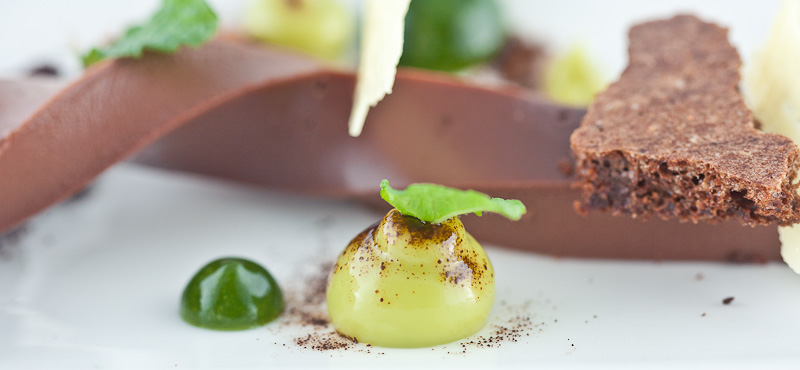
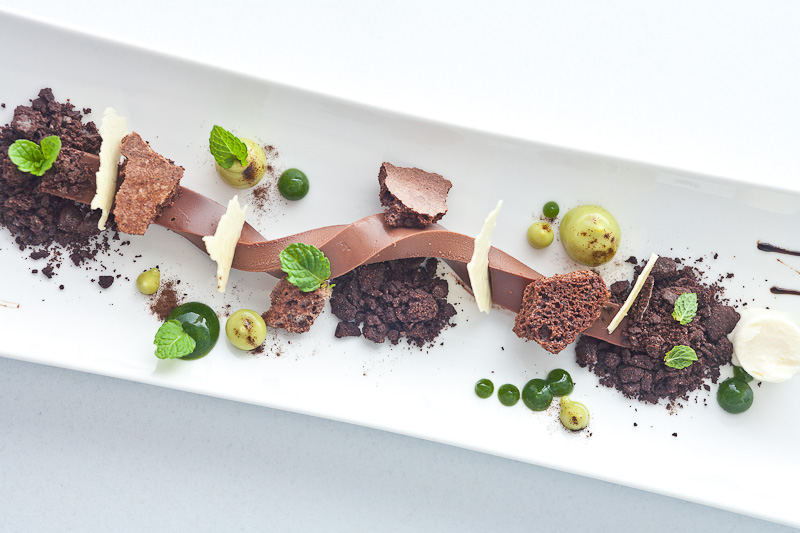
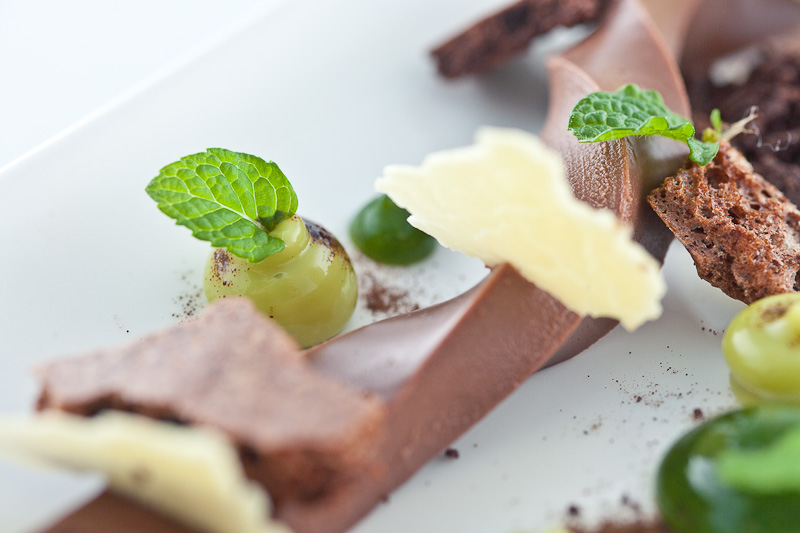
I then got to work on making ‘dehydrated chocolate mousse’. This involved melting some 72% chocolate with a pinch of salt, then stirring in some egg yolks to the mixture. The chocolate sort of seizes up, but not quite as firmly as if I’d thrown in water. At the same time, I whip some egg whites and sugar to stiff peaks, then fold the resulting meringue into the chocolate a bit at a time. I end up with a fluffy, spongy chocolate mousse. I spread this in a dehydrator tray and let it dehydrate overnight. What I end up with is a flat pad of very airy, crispy chocolate. This gets broken into small pieces for plating.
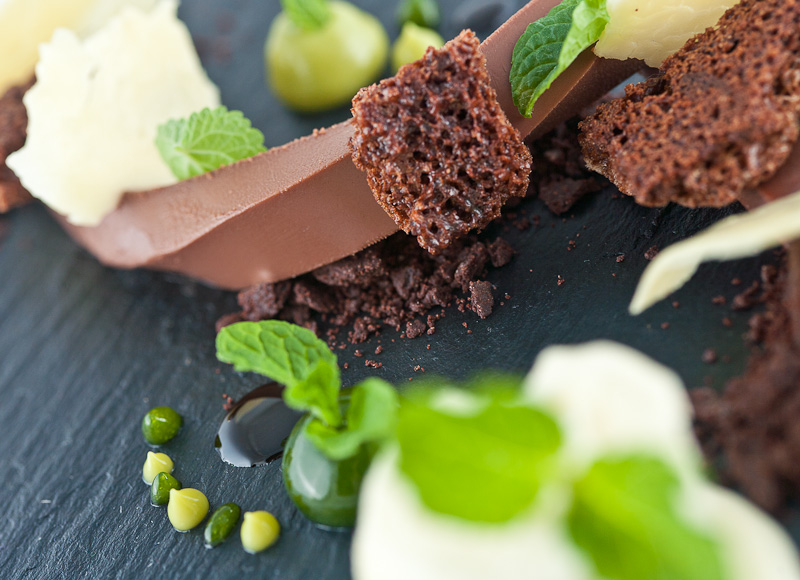
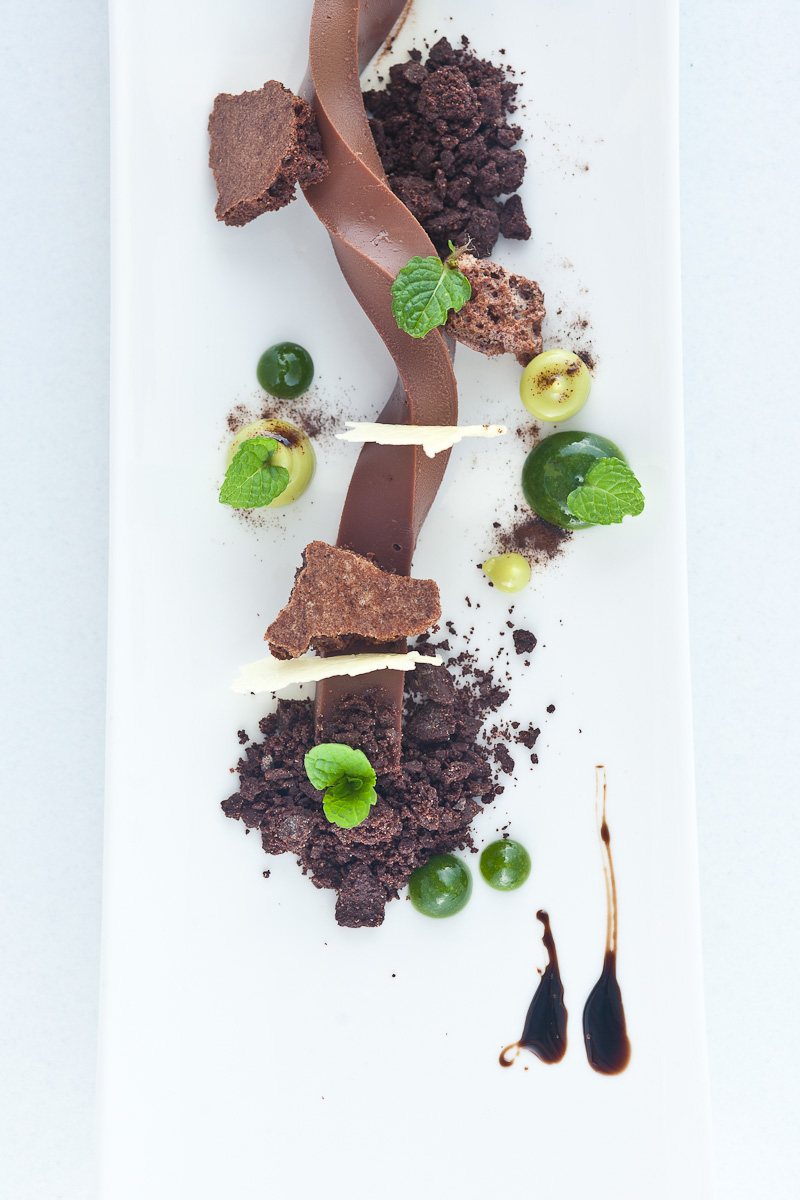
Next up was ‘dehydrated lime curd’. Sarah and I were introduced to curd in New Zealand by Jeannie; smearing it on toast in the mornings is delicious. Curd is traditionally made by cooking fruit juice, eggs, butter, and egg yolks slowly until the yolks cause the mixture to thicken. This curd is helped along with some agar as a thickening agent. After I made a (enormous…again you can quarter or third this one pretty safely) batch of curd, I spread some of it out on a dehydrator tray and dehydrated it overnight. You have to spread it very, very thin to get it to crisp up into the potato-chip-like texture that’s required…I learned this the hard way.
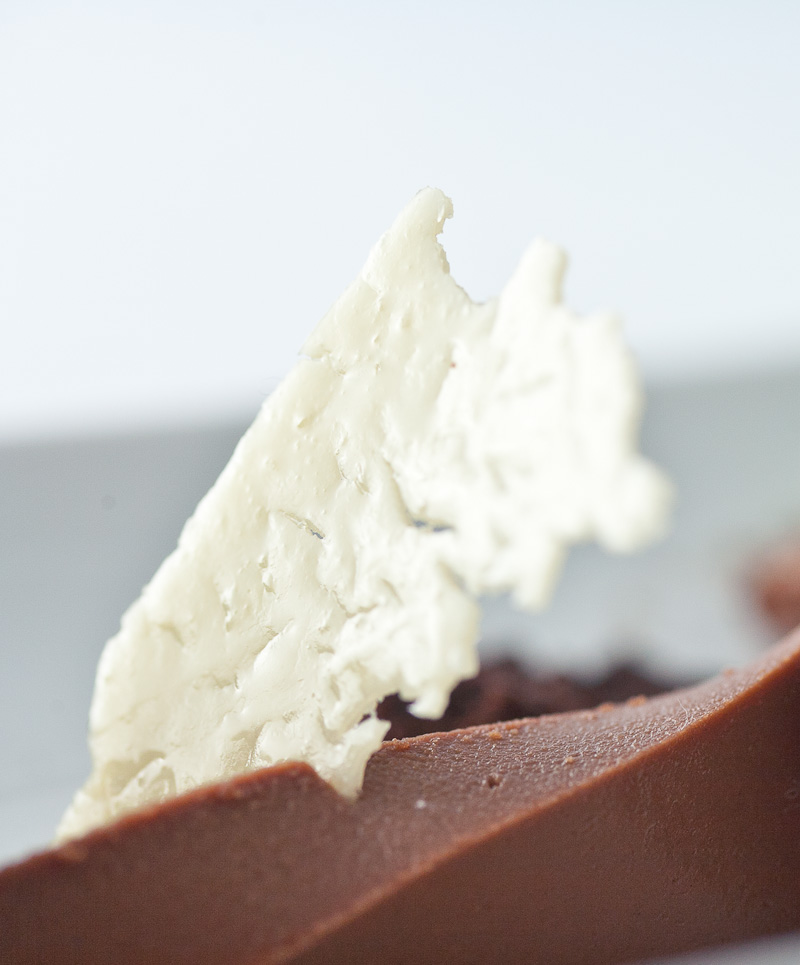
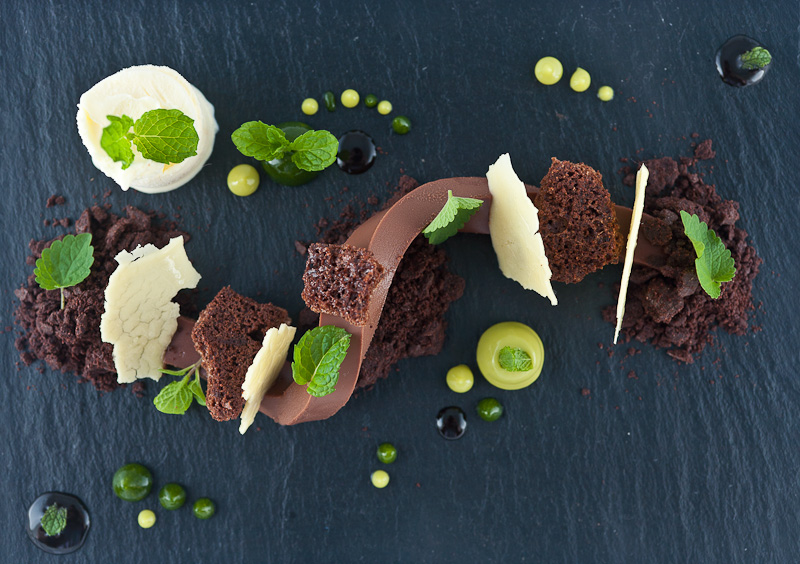
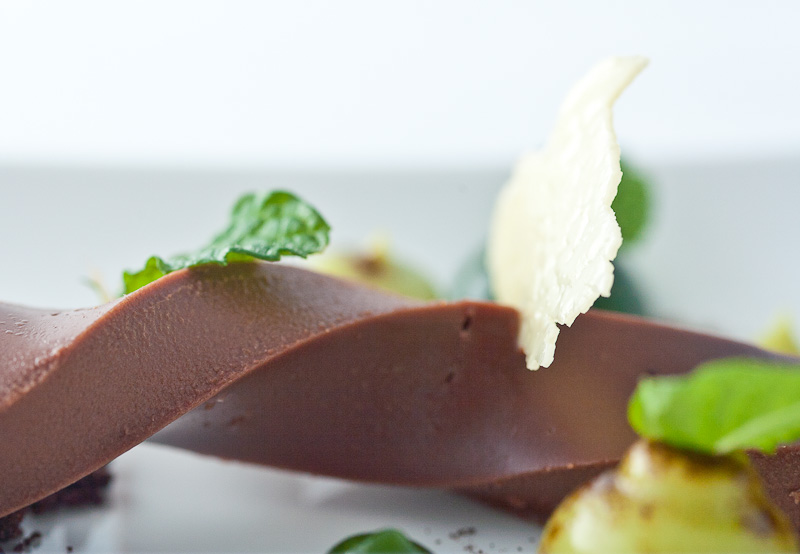
Lime ice cream is made with some skim milk, butter (!), glucose, and egg yolks, and stabilized with xanthan. Yet again this recipe yielded maybe 3x what I’d consider a reasonable amount, even for this cookbook. It was so much that I couldn’t fit it all in my blender or ice cream maker all at once. Despite all the butter and eggs, the resulting ice cream is very, very light and airy, almost whipped cream, and the lime taste is delicate and subtle.
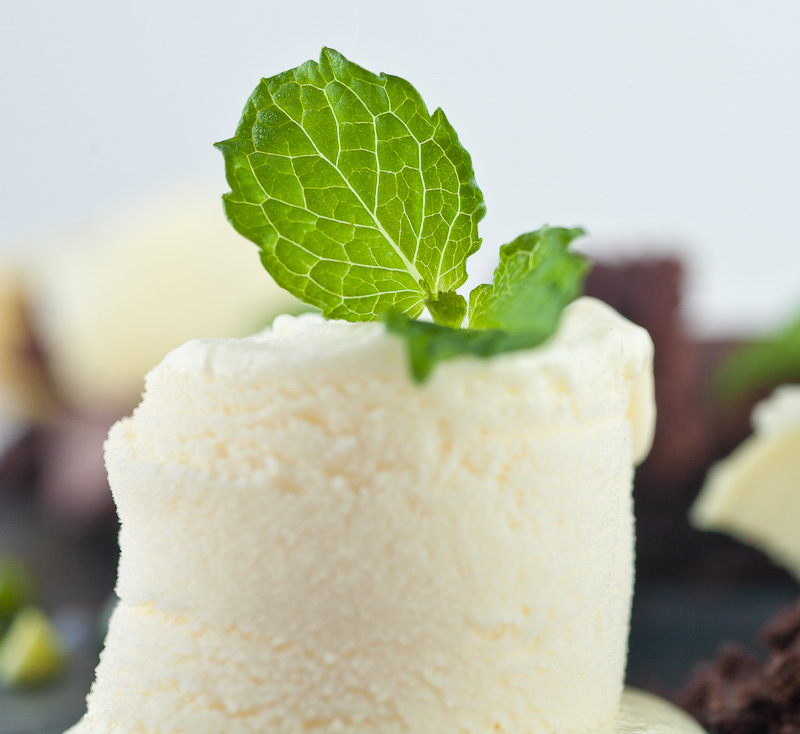
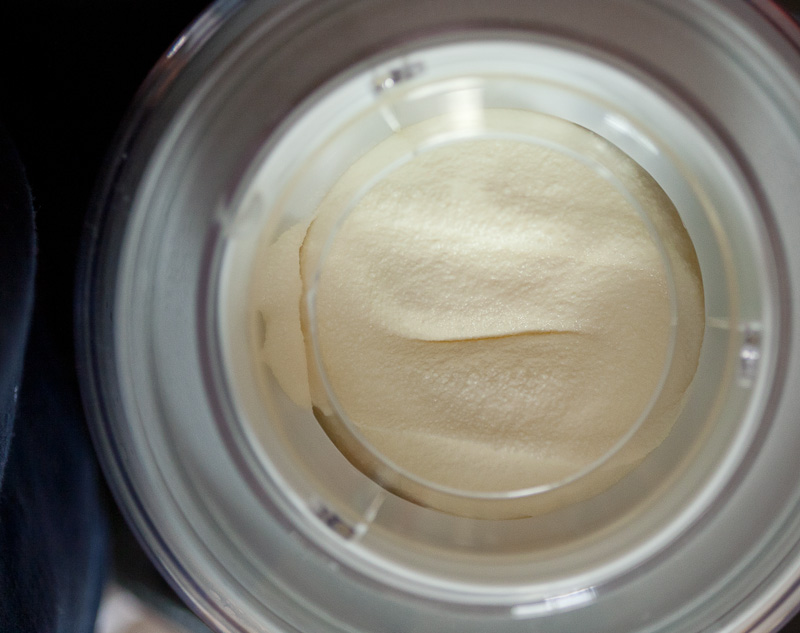
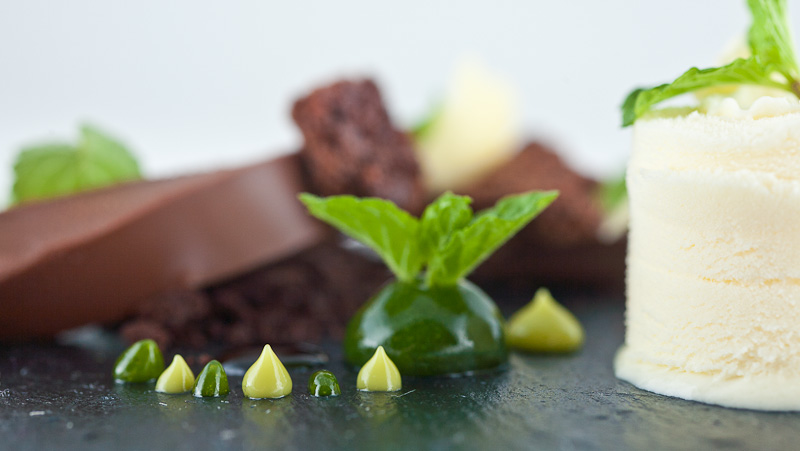
Next I made ‘cocoa crumbs’, which are a little bit like glorified chocolate cookies ground up in a food processor. The recipe instructs me to make a dough from butter (a lot of butter), sugar, and eggs. Just to give you an idea of what I mean by “a lot of butter”:
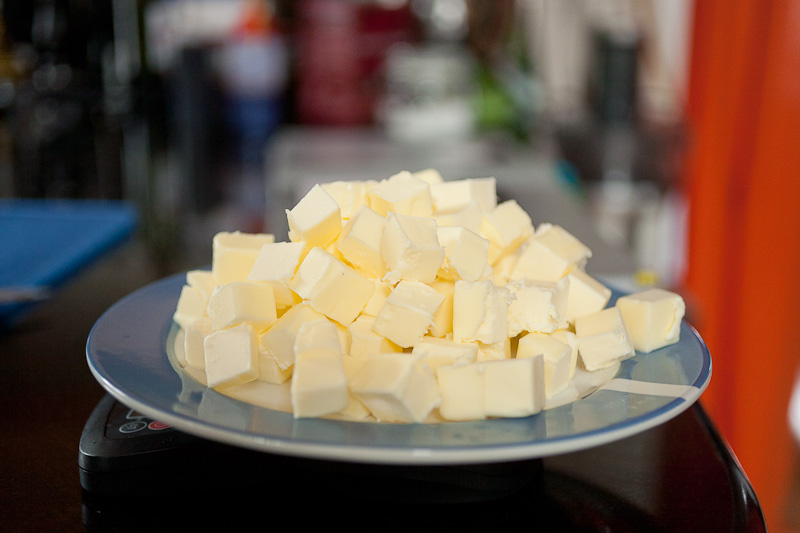
I put this in a food processor, and poured in a lot of cocoa powder:
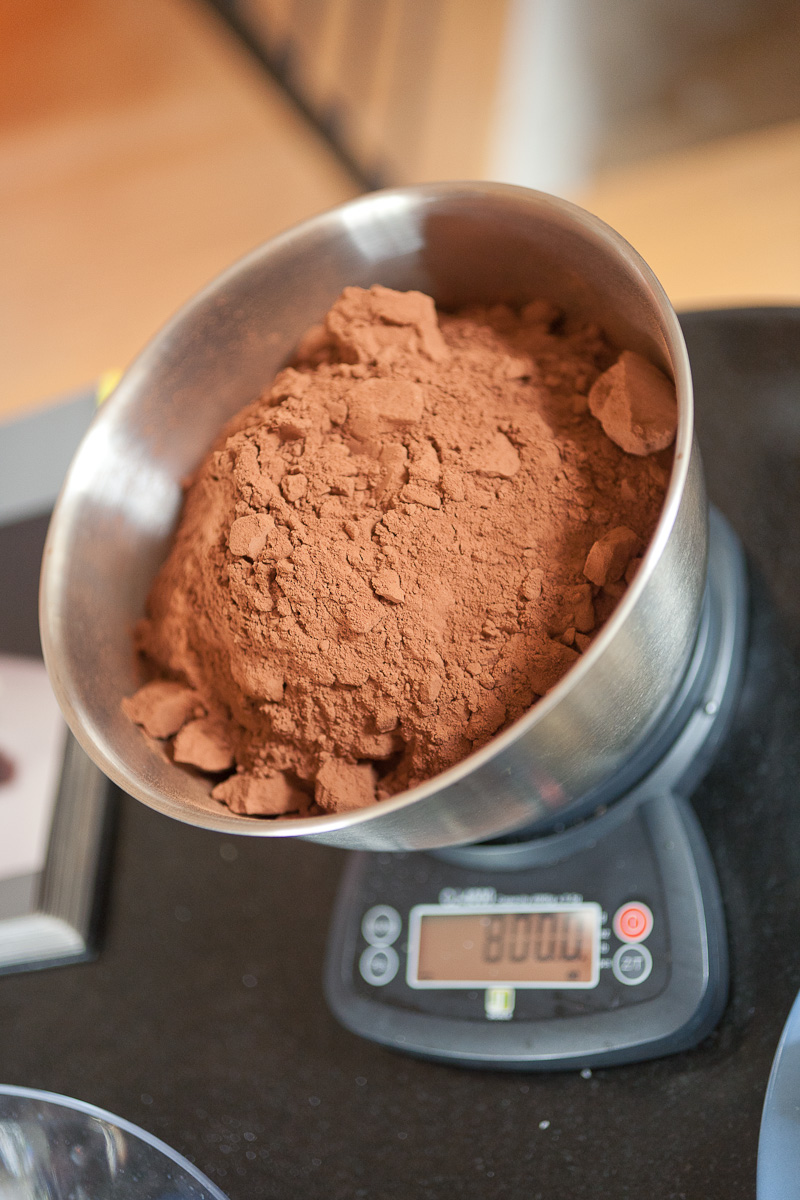
All of this led to a lot of mess:
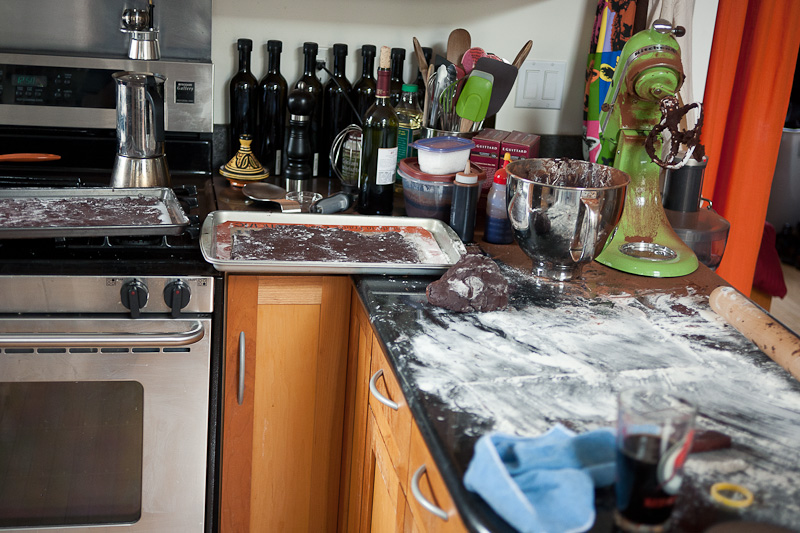
You know how cocoa powder sort of poofs out the top when you open it? Yeah, imagine a lot of that happening while the mixer is running. I wasn’t anticipating this, and managed to lightly dust most of our kitchen in cocoa powder. But I ended up with a firm chocolate dough that I rolled out and baked on a sheet tray, then processed in a food processor to the consistency of small crumbs. Before I broke it all up, I took a chunk of it and threw several of the garnishes on top just to check the flavor of everything…it was exciting.
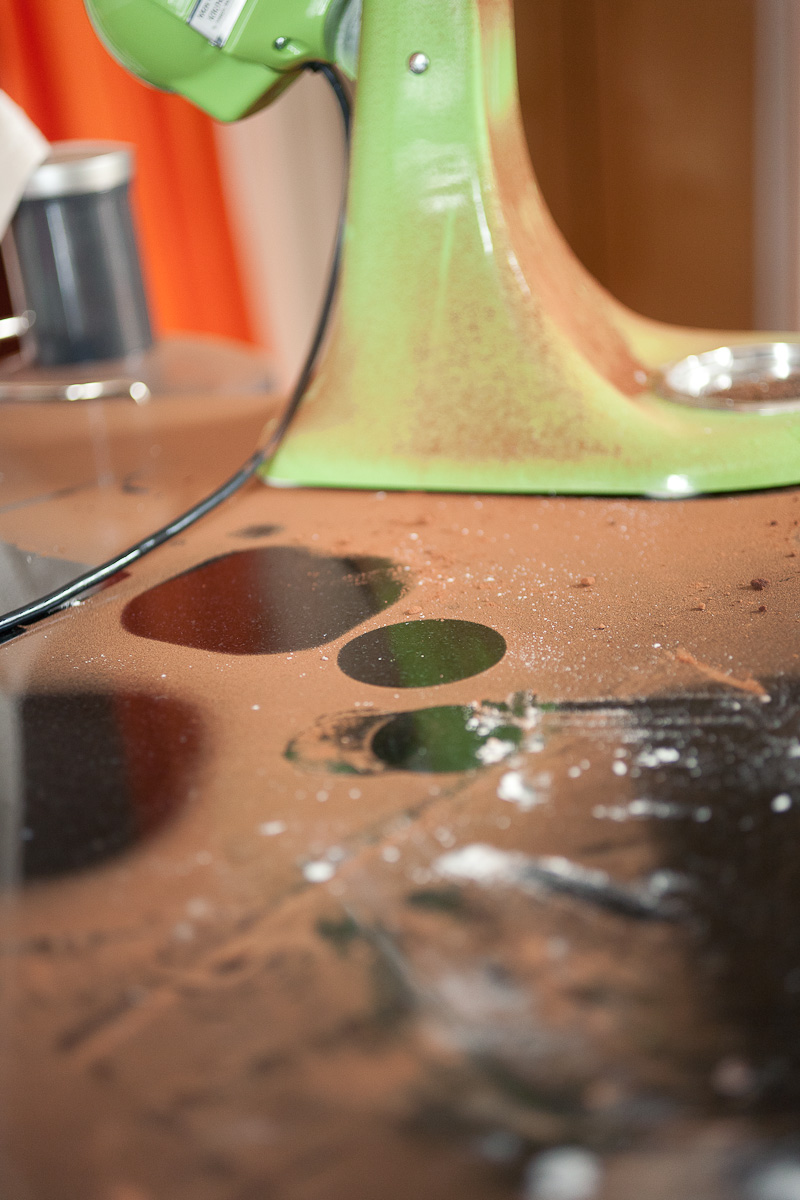
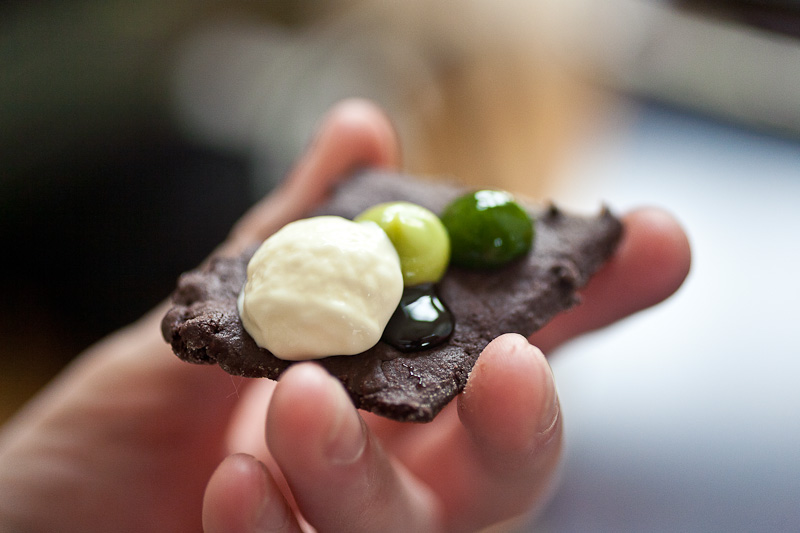
Finally, the pliable chocolate ganache. I was telling someone at work about making this this weekend, and they asked “So…how do you make pliable chocolate?” The short answer is, I’m afraid, “Magic.” Pliable chocolate ganache is a crazy concoction of agar, gelatin, sorbitol, cream and chocolate. I can take some basic educated guesses as to what each of these ingredients do, but trying to reverse-engineer this stuff would be a pretty significant feat. Sorbitol is a sugar substitute that’s also often used as a humectant; retaining moisture seems like a pretty important thing when making pliable chocolate, so my guess is that’s why it’s used instead of sugar. The gelatin and agar work together to yield a gelled milk-chocolate mixture that’s flexible but strong, and when it warms to room temperature it’s melty and luxurious (rather than like eating chocolate jell-o). Honestly this stuff is just amazing, and I dig that after all this time working through this book, there are still things that blow my mind and keep me learning.
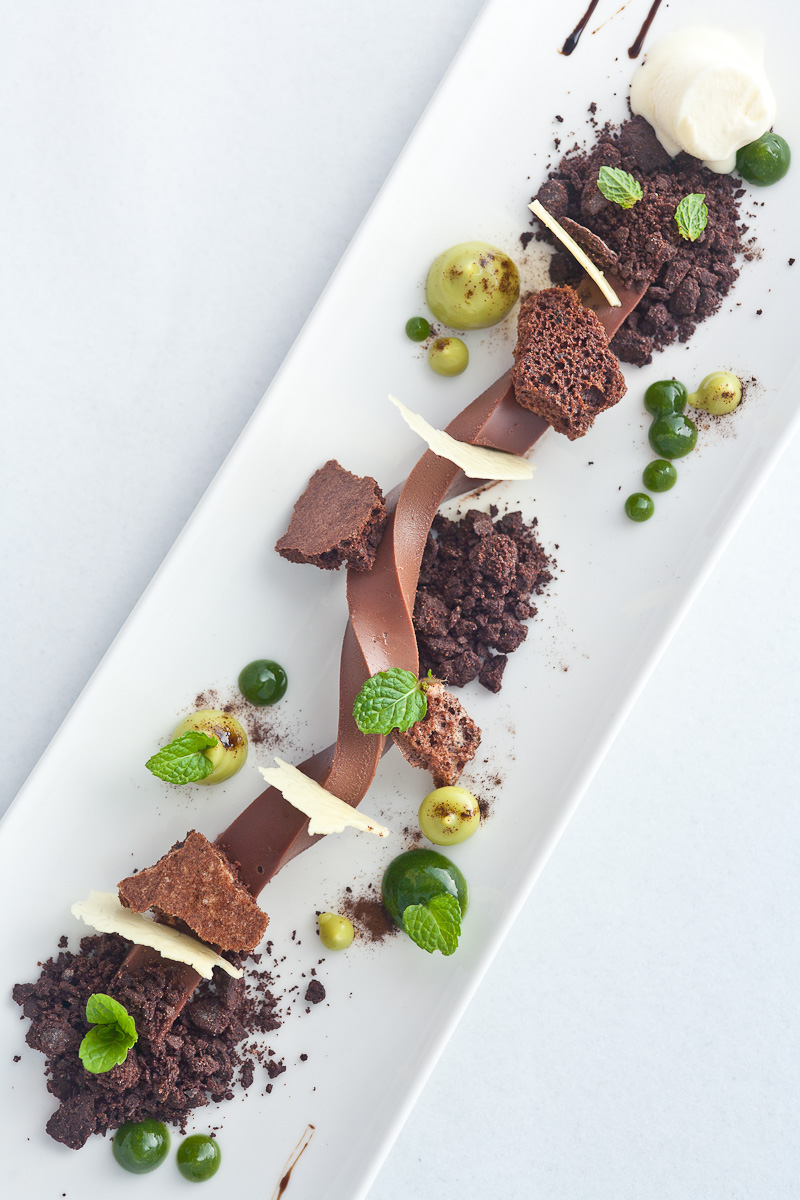
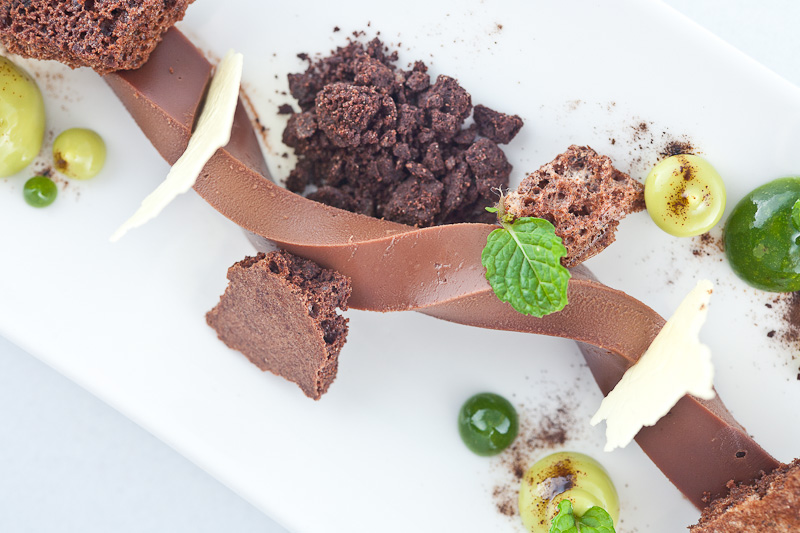
I had to make this twice though; the first time I ended up with a soggy, sloppy mess. I think it’s because I used a bit of agar I’d bought in New Zealand from a health food shop, which is of a little lower grade than what I typically work with. I was trying to use it up, and forgot that it behaves a little differently when heated. It’s coarse and less-refined, so weighing it out is misleading and yields a ton of unused cruft floating around in my mixture. The cookbook also omits one vital step; it mentions boiling agar in a syrup of sorbitol and water, and then instructs me to add cream, which is then mixed into hard chocolate. You need to bring the cream to a boil again before doing this though; it helps the remaining agar to dissolve and also makes the chocolate melt more-uniformly.
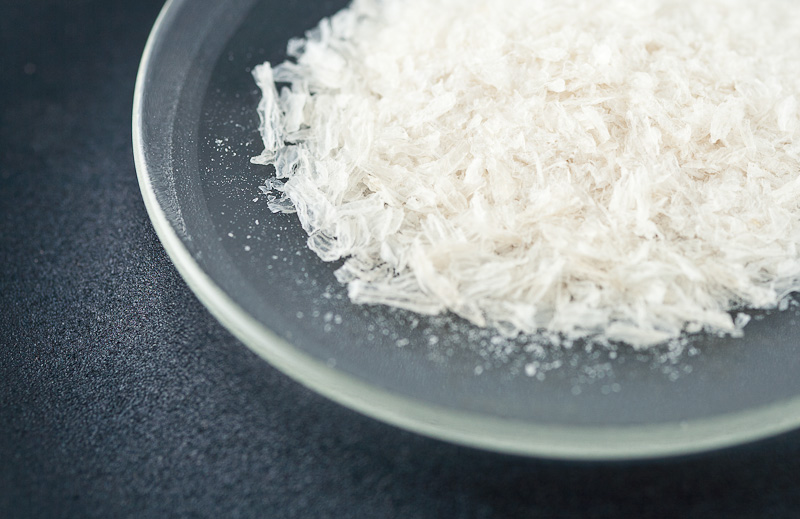
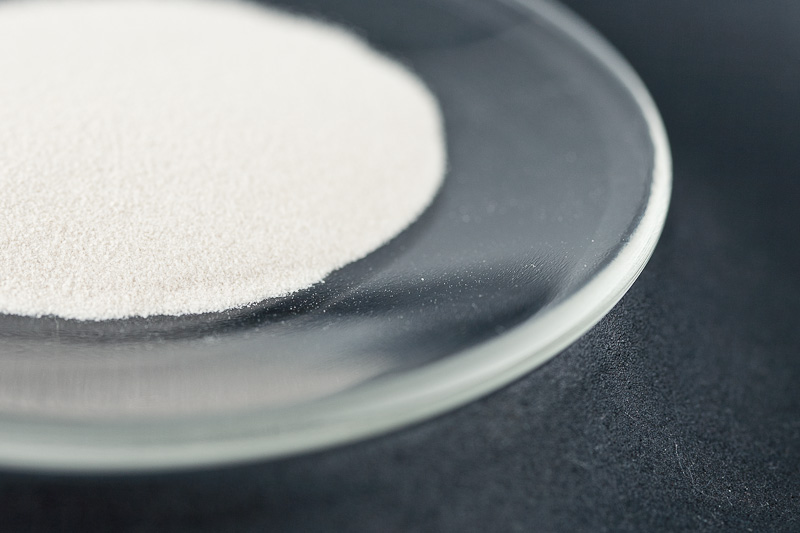
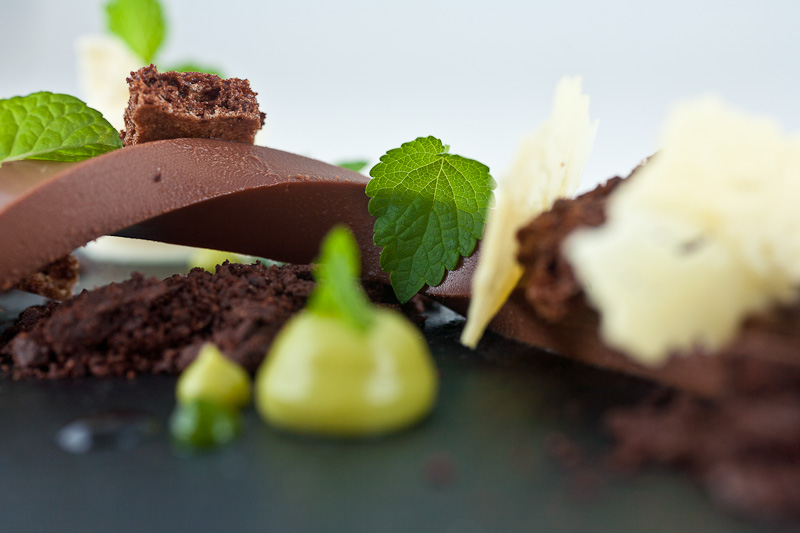
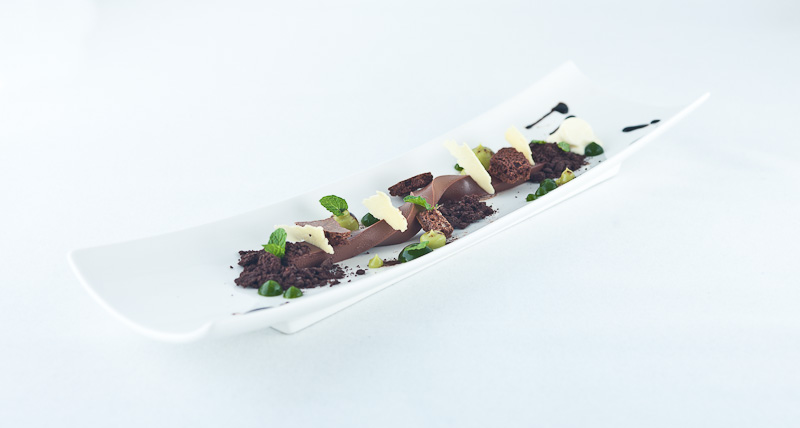
So, after all this…how was it?
AWESOME.
Visually it’s one of the more-striking dishes I’ve made; I absolutely love the colors, and the impossible antigravity spiral of chocolate is amazing to see. But that’s only half the story; the taste of this is just beautiful. The tartness of the lime curd and ice cream work wonderfully to cut the rich chocolate ganache, and the crunchy mousse and crumb bits help keep enough textural variety that one doesn’t feel overloaded. The avocado and mint puddings are lovely accents, as are the garnishing mint leaves themselves. Sprinkled licorice extract powder and drops of licorice syrup also serve as nice little accents. Overall it tastes as amazing and delicious as it looks, and once again I smile at how fun this continues to be.
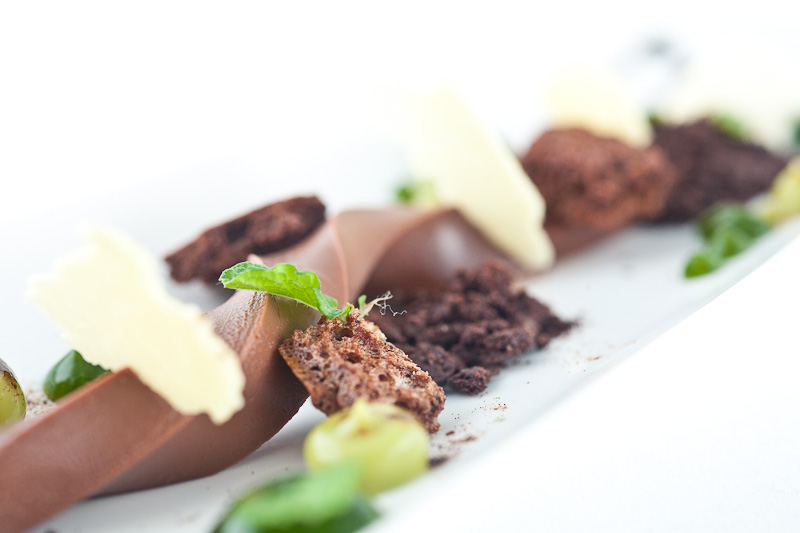
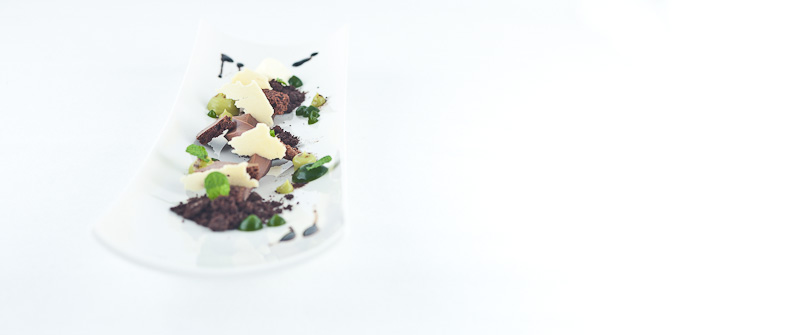
Yum.
Looks great! I’ve made the pliable chocolate ganache numerous times, and have never really managed to twirl it as much as you’ve achieved without it breaking. Did you run into any issues with the strips breaking when twisted or bent too much?
Thanks man! Yeah, I did notice it tended to break if I got too much loft in the spiral…and annoyingly, it wouldn’t happen suddenly. It’d break after I’d made it through about half the rest of the plating.
My friend Kris wondered last year about the idea of making a pliable pumpkin spiral, using this recipe as a basis. I’d kinda like to try that now, just to see what ingredients are actually doing the bulk of the work in terms of pliability. It seems like the agar and gelatin would be the ones, but I’m curious if the cocoa butter or sorbitol are doing something important.
Beautiful work Allen. I’d be very curious about the function of sorbitol in pliability as well. I don’t have it and was not planning on buying any just for that. The idea of pliable pumpkin “pudding” is very interesting. I might have to just “borrow” that one :).
1st off this is one of my favorite posts you have done, pictures are amazing. 2nd I have never had much success with the pliable chocolate,mine always is too soft and runny but I may have to try it again after seeing this post 🙂
Wicked cool post, Allen. Having bought a fuck-ton of chocolate for the dish, do you have anything to say about personal preferences? In the picture, I see that you have a bar of Scharffen Berger and some Guittard. Did you just end up buying two brands because you needed 70% and 72% chocolate? I haven’t made any macarons in a while, but as I’m sure you know, there’s usually some kind of ganache involved, and the more I know about chocolate, the better.
Hey thanks Katie! (and everyone else!)
Re: the chocolate, I have to admit it was largely laziness. There’s a bakery shop in Berkeley that’s sort of near me but also a pain to get to during workdays. They have an amazing selection of bulk chocolate in almost every percentage and brand you could imagine, and ultimately I consider it my favorite place to buy. But, I happened to be at Whole Foods and saw the Guittard and figured I’d save an hour of my time and snag it. It worked pretty ok but I wouldn’t say the taste was my favorite, and the first time I made the ganache it didn’t melt very nicely…it was ‘particle-y’? Anyway, at that point, Sarah was at work (so she had the car) and I didn’t feel like biking all the way to the bakery shop or to Whole Foods to replenish, so I went to our local grocery and bought the closest thing I could find, which was that Scharffen Berger stuff. I have to say I preferred it’s taste/consistency and the way it melted, despite being 2% less cacao mass than the recipe called for. I figured that small a percentage wouldn’t make a huge difference. We also have some Tcho Pro stuff that tastes really nice and that I’m dying to play with but it’s only 60% cacao, so I didn’t want to roll the dice with that on this temperamental dish.
Thanks for the advice, Allen. I envy you and that bakery shop. For a so-called “foodie town” Chicago doesn’t seem to have that many serious specialty food shops. (Or maybe I just need to look harder. ) Usually, I don’t have the luxury of choosing between Guittard and Valrhona, say. I’ve never heard of Tcho Pro, but I hope you get a chance to play with it and post about it soon.